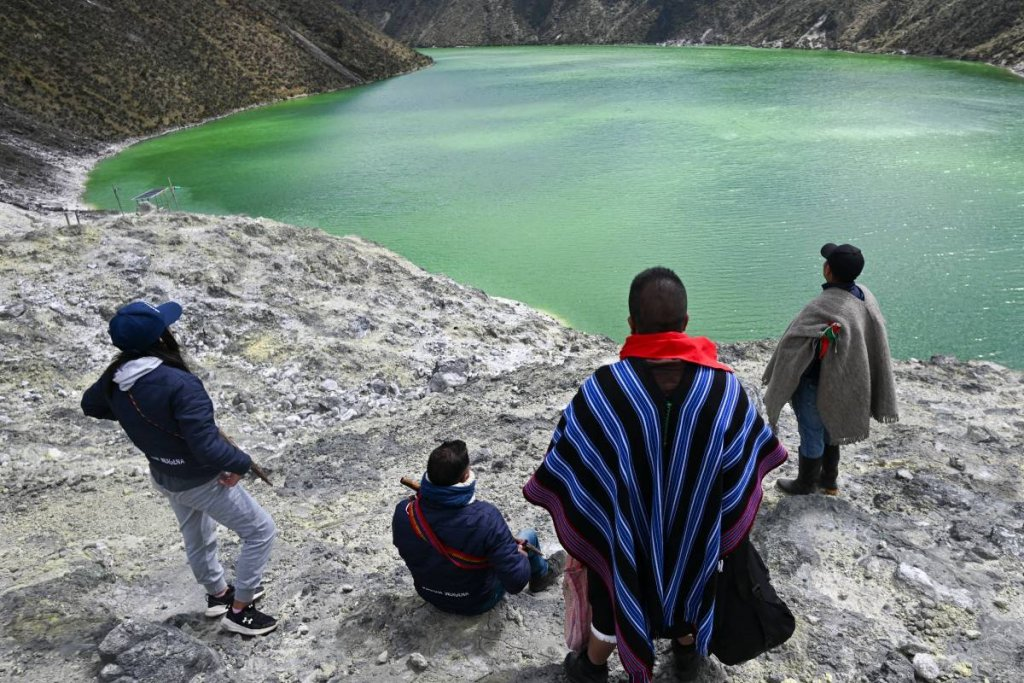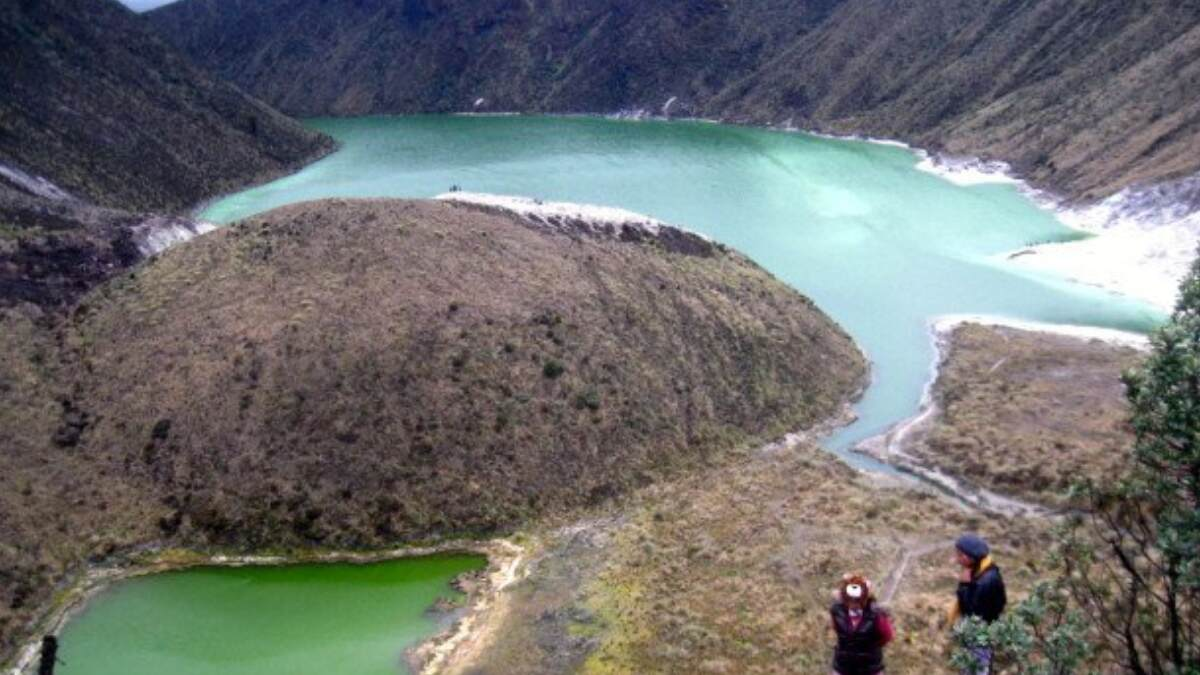For centuries, Laguna Verde, a stunning lake nestled in the crater of a semi-dormant volcano in southwest Colombia, has been a sacred site for the Indigenous Pastos community.
The lake, with its ever-shifting hues of green, holds deep spiritual significance for the local people and has become a symbol of their resilience in preserving both their cultural heritage and the natural beauty of their homeland.
However, the increasing influx of tourists threatened the very sanctity of this unique ecosystem, leading the Pastos to take decisive action to protect it. Their efforts have drawn international attention and praise, highlighting the importance of sustainable tourism and Indigenous stewardship in preserving the environment.
The Sacred Significance of Laguna Verde
Laguna Verde, or Green Lake, is a hidden gem high in the Colombian Andes, located within the Azufral volcano, which rises to an impressive 4,070 meters (2.5 miles). For the Pastos people, this lake is more than just a scenic destination; it is a sacred site imbued with spiritual meaning.
The spirits of the lake are believed to guard it, and disturbing the tranquility of the area is seen as an affront to both the spirits and the natural world. Before ascending the volcano, Indigenous guards perform rituals led by shamans to ask for permission from the spirits to visit the lake and apologize for any disruption their presence might cause.
Read : Colombia: Unveiling the Vibrant Culture and Stunning Landscapes of South America
The spiritual reverence for the lake is deeply tied to the Andean belief in Pacha Mama, the Mother Earth goddess. This belief system emphasizes harmony with nature and the cyclical nature of life.
Read : Top Ten Destinations to Capture Vibrant Culture and Scenic Beauty in Colombia
The Indigenous guardians perform rituals to honor both Pacha Mama and the Virgin Mary, blending traditional Andean spirituality with Catholic influences. These ceremonies reflect a profound respect for the environment, and the lake’s importance as a site of spiritual and ecological balance is central to the Pastos’ way of life.
The Impact of Uncontrolled Tourism
For years, Laguna Verde was one of Colombia’s best-kept secrets. The stunning green hues of the lake, varying from emerald to turquoise, combined with the challenging two-hour ascent, made it a sought-after destination for adventurous travelers.
However, once the secret was out, the lake became overwhelmed with tourists, often numbering up to 1,500 visitors per day. This surge in tourism brought with it a range of problems that began to degrade the very ecosystem the tourists had come to admire.
Visitors arrived on motorbikes, disturbing the serenity of the sacred site and trampling the delicate flora, such as the espeletia plants that are crucial to the paramo ecosystem. These plants are emblematic of the unique high-altitude environment that surrounds the lake.

Worse still, fecal contamination was found in the lake’s drinking water, a clear sign that the increasing human presence was jeopardizing both the environmental and spiritual sanctity of the site. Rubbish left behind by tourists added to the degradation, and the situation became untenable for the Indigenous community.
In 2017, the Pastos took the drastic step of closing Laguna Verde to the public in a bid to restore its pristine condition. The decision was backed by local authorities, and over the course of several weeks, the area underwent a major cleanup operation.
Rubbish was removed, and efforts were made to restore the natural beauty of the lake and its surroundings. Today, seven years after the closure, Laguna Verde is once again pristine, with no visible signs of human interference beyond the narrow climbing path used by the Indigenous guards.
Balancing Conservation with Sustainable Tourism
The closure of Laguna Verde has been effective in preserving the natural and spiritual sanctity of the site, but it has also sparked debate within the local community and beyond. Narino, the region where the lake is located, is one of the poorest in Colombia.
For some, the prospect of reopening the lake to tourists, albeit in a controlled manner, presents an opportunity for economic development. Tourism officials in the region have suggested a sustainable model that would limit the number of visitors to just ten or twenty people per day, ensuring that the environmental impact is kept to a minimum while still allowing some form of tourism to continue.
Indigenous leaders, such as Jorge Arevalo, a member of the lake’s guard, have expressed openness to the idea of controlled tourism, provided it respects the sacredness of the site. Arevalo emphasized that the Pastos are not opposed to tourism itself but to the uncontrolled tourism that had previously wreaked havoc on the lake.
The possibility of reopening the site under strict guidelines could provide a way to balance the community’s economic needs with the environmental and spiritual preservation of Laguna Verde.
The success of the Pastos in managing the lake’s closure has not gone unnoticed. The European Union has recognized the Indigenous community’s efforts and invited them to speak at the upcoming UN COP16 biodiversity conference in Cali, Colombia.
The Pastos will share their experiences in sustainable tourism management, demonstrating how Indigenous stewardship can play a critical role in preserving ecosystems that are not only important to local cultures but also vital for global environmental health.

As Gilles Bertrand, the EU ambassador to Colombia, noted, the preservation of Laguna Verde helps maintain the ecological balance in the Andes and the wider Amazon region. This work, in turn, contributes to the stability of the global climate, making the efforts of the Pastos community relevant far beyond the borders of Colombia.
The story of Laguna Verde is a powerful reminder of the importance of Indigenous stewardship in protecting both cultural heritage and the environment. The decision to ban tourists from the sacred lake was not taken lightly, but it was necessary to preserve the site’s pristine beauty and spiritual significance.
The Pastos community’s efforts have set an example for sustainable tourism management, one that respects the environment and the cultural traditions of Indigenous peoples.
As the world grapples with the growing challenges of climate change and environmental degradation, the lessons from Laguna Verde serve as a beacon of hope. By placing the preservation of nature and culture at the forefront of decision-making, it is possible to create a model of tourism that benefits both local communities and the planet as a whole.
let’s enjoy few years on earth with peace and happiness….✍🏼🙏

